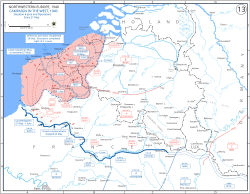| Siege of Lille | |||||||||
|---|---|---|---|---|---|---|---|---|---|
| Part of the Battle of France in the Second World War | |||||||||
 Situation, 21 May – 4 June 1940 | |||||||||
| |||||||||
| Belligerents | |||||||||
|
|
| ||||||||
| Commanders and leaders | |||||||||
|
Jean-Baptiste Molinié (POW) Alphonse Juin (POW) Gustave Mesny (POW) |
Alfred Wäger Erwin Rommel Joachim Lemelsen Max von Hartlieb-Walsporn Ludwig Ritter von Radlmeier Fritz Kühne (POW) | ||||||||
| Strength | |||||||||
|
Elements of 6 divisions |
4 infantry divisions | ||||||||
| Casualties and losses | |||||||||
|
| |||||||||
The siege of Lille or Lille pocket (28–31 May 1940) took place during the Battle of France in the Second World War. The siege of the French IV Corps and V Corps (about 40,000 men) of the First Army (General René Prioux) was conducted by four German infantry divisions supported by three panzer divisions.
The III Corps of the First Army had managed to retreat to the Lys river with the British Expeditionary Force (BEF) divisions nearby. The two surrounded French corps resisted German attacks until forced to surrender at midnight on 31 May/1 June. The defence of the Lille Pocket enabled more Allied troops to retreat into the Dunkirk perimeter and take part in the Battle of Dunkirk.
- ^ a b c Lormier 2005, p. 148.
- ^ Shirer 1969, p. 746.
